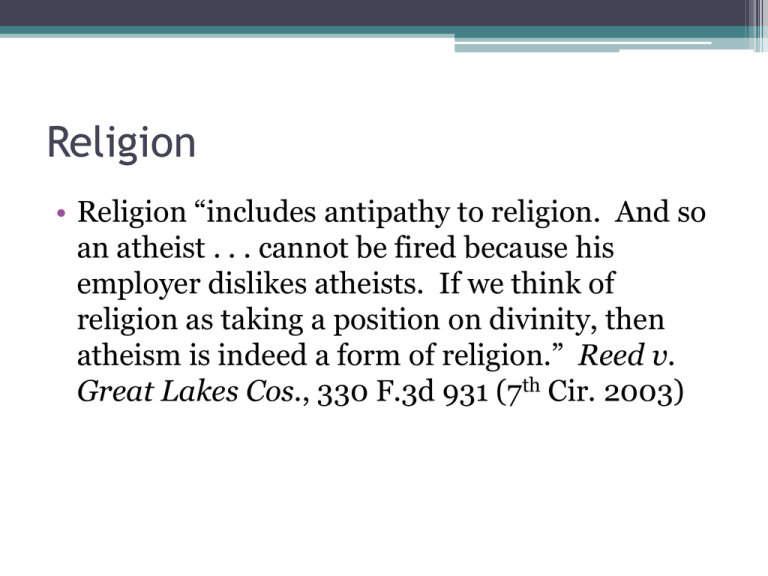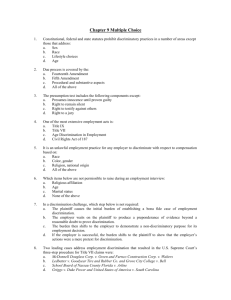Religion
advertisement

Religion • Religion “includes antipathy to religion. And so an atheist . . . cannot be fired because his employer dislikes atheists. If we think of religion as taking a position on divinity, then atheism is indeed a form of religion.” Reed v. Great Lakes Cos., 330 F.3d 931 (7th Cir. 2003) Abercrombie’s “Look Policy” • Promote Abercrombie’s brand and exemplify “a classic East Coast collegiate style of clothing” • Sales floor employees are “Models” • Regulates fingernail length, hair color • Black clothing and “caps” are prohibited Samantha Elauf Religion • EEOC v. Abercrombie & Fitch (U.S. 2015) • “An employer may not make an applicant’s religious practice, confirmed or otherwise, a factor in employment decisions.” • Title VII gives religious practices “favored treatment” and “requires otherwise-neutral policies to give way to the need for an accommodation.” Abercrombie & Fitch (cont.) • Case settled • Elauf paid $25,670.53 in damages, $18,983.03 in court costs Religion • Title VII Sec. 702: “This subchapter shall not apply . . . to a religious corporation, association, educational institution, or society with respect to the employment of individuals of a particular religion to perform work connected with the carrying on by such corporation, association, educational institution, or society of its activities.” The Religion Clauses • “Congress shall make no law respecting an establishment of religion, or prohibiting the free exercise thereof . . .” U.S. Const. amend. I (1791) Religion • Hosanna-Tabor Evangelical Lutheran Church and School v. EEOC (U.S. 2012) ▫ Facts; issue • The “ministerial exception” and the “unwanted minister” • Held: the ministerial exception bars the plaintiff’s ADA suit Sex Discrimination • • • • Title VII Sec. 703(a) Bona fide occupational qualifications Title VII Sec. 704(b) “Sex” “Gender” Sex Discrimination—Compensation Differentials • The Equal Pay Act of 1963, 29 U.S.C. Sec. 206(d): no employer “shall discriminate . . . between employees on the basis of sex by paying wages to employees in such establishment at a rate less than the rate at which he pays wages to employees of the opposite sex in such establishment . . . for equal work on jobs the performance of which requires equal skill, effort, and responsibility, and which are performed under similar working conditions . . .” Sex Discrimination—Compensation Differentials • The Equal Pay Act exceptions: “payment is made pursuant to (i) a seniority system; (ii) a merit system; (iii) a system which measures earnings by quantity or quality of production; or (iv) a differential based on any other factor other than sex . . .” 29 U.S.C. Sec. 206(d) Sex Discrimination—Compensation Differentials • Title VII Sec. 703(h) and the Bennett Amendment: not unlawful “to differentiate upon the basis of sex in determining the amount of the wages or compensation paid or to be paid to employees . . . if such differentiation is authorized by the provisions of section 206(d) of title 29.” Sex Discrimination—Compensation Differentials • County of Washington v. Gunther (U.S. 1981) ▫ Facts; issue • The purpose of the Bennett Amendment • The two parts of the Equal Pay Act: ▫ The “purely prohibitory” part 1, and the affirmative defenses in part 2 • Held: discriminatory undercompensation claims are not barred by Sec. 703(h) merely because the plaintiffs did not perform work equal to work performed by male guards Gunther (cont.) • Justice Rehnquist’s dissent • Congress intended to “require all sex-based wage discrimination claims, whether brought under the Equal Pay Act or under Title VII, to satisfy the ‘equal work’ standard.” • “Comparable work” is not “equal work” Equal Pay Act • 29 U.S.C. Sec. 206(d) • “[A]n employer who is paying a wage rate differential in violation of this subsection shall not, in order to comply with the provisions of this subsection, reduce the wage rate of any employee.” Sex Discrimination—Compensation Differentials • Ledbetter v. Goodyear Tire & Rubber Co. (U.S. 2007) • The Lilly Ledbetter Fair Pay Act (amending Title VII Sec. 706(e)(3)(A)) Sex Discrimination—Comparable Worth • AFSCME v. State (9th Cir. 1985) ▫ Facts; issue • Comparable work theory • Disparate impact claim? ▫ The “case does not involve an employment practice that yields to disparate impact analysis.” ▫ Number of complex factors, multi-faceted assessment AFSCME (cont.) • Disparate treatment claim? • The Willis study and relying on market rates in setting salaries • “Neither law nor logic deems a free market system a suspect enterprise.” • No indication that Congress intended to “abrogate fundamental economic principles such as the laws of supply and demand . . .” AFSCME (cont.) • Court: after receiving the Willis study, the state did not have to implement a comparable pay system • Holding • Agree or disagree? Sex Discrimination—Compensation Differentials • City of Los Angeles, Dept. of Water & Power v. Manhart (U.S. 1978) ▫ Facts; defined benefit plan; issue • “Women, as a class, do live longer than men.” • Determining “discrimination”: class characteristics or individual characteristics? • The Bennett Amendment Manhart (cont.) • The employer’s General Electric v. Gilbert argument • No Title VII cost-justification defense • Held: the Department violated Title VII ▫ Note: defined contribution plans are not unlawful ▫ The retroactive relief issue • Justice Blackmun: life expectancy is “a nonstigmatizing factor”; Chief Justice Burger: longevity is “an other factor other than sex” • Justice Marshall: would order refund of excess contributions Sex Discrimination—Compensation Differentials • Arizona Governing Comm. v. Norris (U.S. 1983) (per curiam) ▫ Facts; pay-out options; issue • Held: practice violates Title VII’s is sex discrimination prohibition • Held: benefits made from post-decision contributions must be calculated without regard to sex Norris (cont.) • Justice Marshall’s opinion • Unlawful to discriminate on the basis of sex at the pay-out stage of a retirement plan • Employer is legally responsible for the discrimination because it chose the companies participating in the plan Norris (cont.) • Retroactive relief issue • (1) Benefit disparity attributable to postManhart contributions: female retirees’ raising benefits must be raised to the level paid to similarly situated male employees Norris (cont.) • (2) Benefit disparity attributable to pre-Manhart contributions ▫ If the employer could have applied sex-neutral actuarial tables without violating male employee’s contractual rights, a female retiree’s benefit coming due after the district court’s judgment must be supplemented ▫ If the employer could not have applied sex-neutral tables without violating contractual rights of male employee, relief should not be awarded

